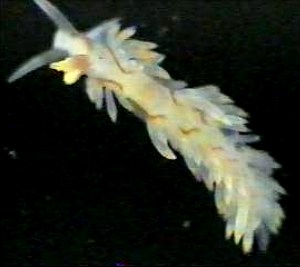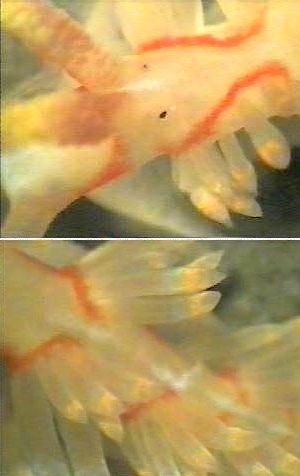

Berghia rissodominguezi
Muniain & Ortea, 1999
Order: NUDIBRANCHIA
Superfamily: AEOLIDINA
Family: Aeolidiidae
DISTRIBUTION
Known only from the western Atlantic from Florida south to Patagonia.
PHOTO
Santa Marta region, Colombia (Caribbean) in less than 1m. Approx 8mm long. Photo: Elianny Dominguez.
I have copied here the part of the original description dealing with the external features:
Animal thin and elongate, 52 mm in length. General body colour translucent white. There are oblique bright orange lines on the borders of the insertion of the cerata and in front of the rhinophores. Over the head and between the rhinophores is an orange triangle. Translucent ceras with central reddish-brown diverticulum, ending in a short white cnidosac. An orange band with a thin subapical red ring around it are present. The digestive gland forms a brown-red dorsal digestive mid-dorsal line, visible through the mantle surface from the third group of cerata back to the last cerata. Rhinophores are long, tuberculate on the lateral and posterior sides, with cream-white coloration and yellow on apical portion. The translucent oral tentacles have a wide area of the same yellow colour covering two-thirds of them. The tentacles are long and slender and approximately twice as long as the rhinophores. Cerata cylindrical and elongate with a rounded apex, uniform in diameter throughout most of their length. There are 6-8 clusters of cerata on each side, containing between 3 to 24 cerata per arch. The anteriormost cluster shows the greatest number of cerata 21-24 (Holotype) and the most curved shape, decreasing in number and length towards the tail. The posterior 1-2 clusters consist of rows 1-3 cerata. The inconspicuous renopericardical prominence is situated between the first and second cerata arches, which are further apart than the others. Foot grooved anteriorly, with elongated foot corners and tapering gradually towards the tail.
Muniain & Ortea (1999) list a number of earlier records of this species which have been previously misidentified. From my own check of the literature, the following clearly refer to this species: Marcus, 1957, as Berghia coerulescens from Brazil; Marcus & Marcus, 1959, as B. coerulescens from Texas; Marcus, 1972, as Berghia verrucicornis from Florida; Thompson, 1980, as B. verrucicornis from Jamaica.
See message from Colombia showing very characteristic orange markings around the ceratal insertion points, and details of eggs and larval development.
References:
• Marcus, Er (1957): On Opisthobranchia from Brazil (2). Journal of the Linnean Society of London, Zoology 43(292): 390-486.
• Marcus, Ev. & Marcus, Er (1960) Some opisthobranchs from the northwestern Gulf of Mexico. Publications Institute Marine Science, University Texas, 7: 251-261. (Pls.1-3)
• Marcus, Ev (1972) On some opisthobranchs from Florida. Bull. Mar. Sci., 22(2): 284-308.
• Muniain, C. & Ortea, J. (1999). First records of the genus Berghia Trinchese, 1877 (Opisthobranchia: Aeolidiidae) from Argentina, with description of a new species. Avicennia, 10-11: 143-150
• Thompson, T.E. (1980) Jamaican opisthobranch molluscs: II Journal of Molluscan Studies, 46(1): 74-99.
Rudman, W.B., 2003 (October 15) Berghia rissodominguezi Muniain & Ortea, 1999. [In] Sea Slug Forum. Australian Museum, Sydney. Available from http://www.seaslugforum.net/factsheet/bergriss
Related messages
-
Re: Berghia columbina? from the Gulf of Mexico
From: Lynn Zurik, February 11, 2004 -
Berghia rissodominguezi = B. columbina
From: Bill Rudman, February 9, 2004 -
Berghia columbina? from the Gulf of Mexico
From: Lynn Zurik, February 9, 2004 -
Berghia rissodominguezi from Colombia
From: Bill Rudman, October 17, 2003 -
Flabellina? from Colombia
From: Elianny Dominguez Tejo , September 14, 2001
